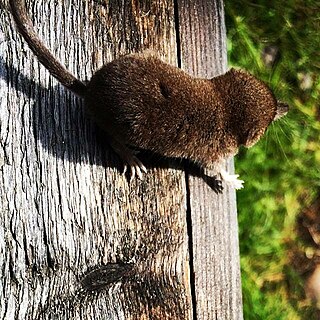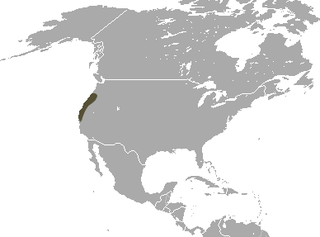
The cinereus shrew or masked shrew is a small shrew found in Alaska, Canada, and the northern United States. This is the most widely distributed shrew in North America, where it is also known as the common shrew.

The American pygmy shrew is a small shrew found in Northern Alaska, Canada, and the northern United States, south through the Appalachian Mountains. It was first discovered in 1831 by naturalist William Cane in Georgian Bay, Parry Sound.

The Arctic shrew, also known as the blackback shrew or saddlebacked shrew, is a medium-sized shrew found in Canada and the northern United States. Separate species status has been proposed for the maritime shrew which is found in New Brunswick and Nova Scotia and had been considered to be a subspecies of the Arctic shrew. The tundra shrew was formerly considered to be a subspecies of the Arctic shrew.

The marsh shrew, also known as the Pacific water shrew, Bendire's water shrew, Bendire's shrew and Jesus shrew is the largest North American member of the genus Sorex. Primarily covered in dark-brown fur, it is found near aquatic habitats along the Pacific coast from southern British Columbia to northern California. With air trapped in its fur for buoyancy, marsh shrews can run for three to five seconds on top of the water. It measures about 16 cm (6.3 in) in length, including a 7-centimetre (2.8 in)-long tail, and weighs an average of 14.5–16 g (0.51–0.56 oz). The marsh shrew's diet consists mainly of invertebrates, which it hunts on land and in the water. They are rare; their populations are thought to be in decline, and they are considered endangered in parts of their range.

The vagrant shrew, also known as the wandering shrew, is a medium-sized North American shrew. At one time, the montane shrew and the Orizaba long-tailed shrew were considered to belong to the same species.

The genus Sorex includes many of the common shrews of Eurasia and North America, and contains at least 142 known species and subspecies. Members of this genus, known as long-tailed shrews, are the only members of the tribe Soricini of the subfamily Soricinae. They have 32 teeth.

The Eurasian pygmy shrew, often known simply as the pygmy shrew, is a widespread shrew of the northern Palearctic.

The common shrew, also known as the Eurasian shrew, is the most common shrew, and one of the most common mammals, throughout Northern Europe, including Great Britain, but excluding Ireland. It is 55 to 82 millimetres long and weighs 5 to 12 grams, and has velvety dark brown fur with a pale underside. It is one of the rare venomous mammals. Juvenile shrews have lighter fur until their first moult. The common shrew has small eyes, a pointed, mobile snout and red-tipped teeth. It has a life span of approximately 14 months.

The Eurasian least shrew, also called the lesser pygmy shrew, is the second-smallest mammal by mass after the Etruscan shrew.

Laxmann's shrew, or the masked shrew, is a species of shrew. Its range extends from northern Scandinavia and the Baltic to the Sea of Japan, including Hokkaidō, Sakhalin, and the Korean Peninsula. It favours mountain forests but is sometimes found in tundra and moorland, and also in lowland areas as well. It avoids cultivated land.

The Ussuri shrew, also known as the giant shrew, is a species of shrew found in Northeast Asia. An adult Ussuri shrew has a total length including the tail of 137 to 170 mm. It is found in valleys and on the forested slopes of mountains in the Korean Peninsula, northeastern China, and the Russian Far East. It is rarely observed, and its ecology is largely unknown.

The slender shrew is a species of shrew. An adult slender shrew has a weight of 1.5–5.3 g (0.053–0.187 oz) and a body length of 4.7–6.0 cm (1.9–2.4 in), with a tail of 4–5 cm (1.6–2.0 in); this makes it one of the smaller shrews found in its range. It is distributed across northeastern North Korea, Hokkaidō, and the Russian Far East including the Kuril Islands.

Baird's shrew is a species of mammal in the family Soricidae. It is endemic to northwest Oregon. Baird's shrew inhabits moist conifer forests.

The montane shrew is a species of mammal in the family Soricidae commonly known as the dusky shrew. Monticolus is derived from the Latin root word mons meaning mountain. It is found in Alaska, western Canada, the western United States in Washington, Idaho, Montana, Utah, Colorado, New Mexico, Arizona, Oregon, Nevada, and California, as well as in Mexico.

The ornate shrew is a species of mammal in the family Soricidae (shrews). It is endemic to western North America, ranging from Northern California in the United States to Baja California in Mexico. Eight subspecies are known, including the extinct tule shrew, known only from four specimens collected in 1905, and the Suisun ornate shrew, a species of conservation concern in California. Through skull morphology research and genetic testing on Ornate shrew populations, it has been shown that there are three main genetic subdivisions: The Southern, Central and Northern. These three genetic subdivisions of Ornate shrew arose from populations of Ornate shrews getting geographically isolated from other populations.

The Pacific shrew is a species of mammal in the family Soricidae. It is endemic to western Oregon in the United States. The Pacific Shrew is native to western Oregon, more specifically from the Siltcoos lake to the coast going from the border line of Douglas and Lane counties continuing south to the northern parts of California. The first documented Pacific shrew to be caught was found at the mouth of the Umpqua River in 1858. They are normally found in damp areas along creeks in forests and sometimes near collapsed trees. Their refuge is of the utmost importance and they are seldom found far from it. This includes collapsed trees or dense vegetation. They use the flora to build a nest, gathering small plants such as grass, moss, lichen, or leaves into a pile and pushing themselves into the middle.

The fog shrew is a species of mammal in the family Soricidae. It is endemic to northern California and Oregon in the United States.

The southeastern shrew is a species of mammal in the family Soricidae. It is found in the southeastern United States.

The New Mexico shrew is a species of mammal in the family Soricidae. It is found only in New Mexico in the Capitan and Sandia-Manzano Mountains.

The long-tailed shrew or rock shrew is a small shrew found in Atlantic Canada and the Northeastern United States.





















